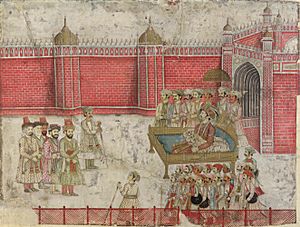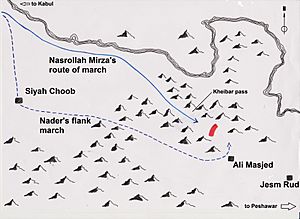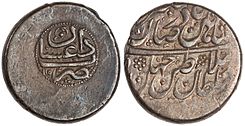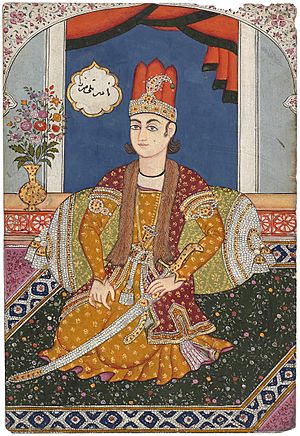Nader Shah facts for kids
Quick facts for kids Nader Shah |
|
|---|---|
|
|
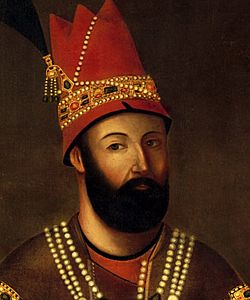
Posthumous portrait painting of Nader Shah, probably Tehran, 1780s or 1790s, now in London's Victoria and Albert Museum
|
|
| Shah of Iran | |
| Reign | 8 March 1736 – 20 June 1747 |
| Coronation | 8 March 1736 - Mughan plains |
| Predecessor | Abbas III |
| Successor | Adel Shah |
| Born | 6 August 1698, or 22 November 1688 Dargaz, Safavid Iran |
| Died | 20 June 1747 (aged 48, or 58) Quchan, Afsharid Iran |
| Burial | Tomb of Nader Shah, Mashhad, Iran |
| Queen | Razia Begum Safavi |
| Issue |
|
| Dynasty | House of Afshar |
| Father | Emam Qoli |
| Religion |
|
| Seal | 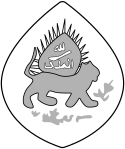 |
| Military career | |
| Battles/wars | Campaigns of Nader Shah |
Nader Shah Afshar (Persian: نادر شاه افشار) was a powerful ruler in Iranian history. He founded the Afsharid dynasty and ruled as Shah of Iran from 1736 to 1747. He was known for his amazing military skills. Some historians even called him the Napoleon of Persia or the Second Alexander.
Nader came to power when Iran was in chaos. A group called the Hotaki Pashtuns had overthrown the weak Shah Soltan Hoseyn. Also, the Ottomans and Russians had taken parts of Iran. Nader reunited Iran and drove out the invaders. He became so strong that he removed the last Safavid rulers and became Shah himself in 1736. His many military campaigns created a large empire. It included parts of what are now Iran, Armenia, Azerbaijan, Georgia, Iraq, Turkey, Afghanistan, and more. However, his constant wars cost a lot of money and hurt Iran's economy.
Nader admired famous conquerors like Genghis Khan and Timur. He copied their military strategies and, later in his rule, their harshness. His victories made him the most powerful ruler in West Asia for a short time. But his empire quickly fell apart after he was killed in 1747.
Contents
Nader's Early Life
Nader Shah was born in a fortress in Khorasan, a region in northeast Iran. His father was a herdsman. Nader's family lived a nomadic life, moving from place to place.
When Nader was 13, his father died. Nader had to support himself and his mother. He gathered firewood to sell in the market. Years later, after conquering Delhi, he told his generals about his difficult childhood. He said, "You now see how high the Almighty has raised me; from this, learn not to look down on people from humble beginnings."
Around 1704, when Nader was about 17, Uzbeks attacked Khorasan. Nader and his mother were captured and taken as slaves. His mother died while in captivity. Nader returned to Khorasan in 1708. At 15, he joined the army as a musketeer. He quickly rose through the ranks and became a trusted assistant to the governor.
Iran's Troubles and Nader's Rise
Nader grew up during the final years of the Safavid dynasty. This family had ruled Iran since 1502. The Safavid Empire was once very strong, but by the early 1700s, it was weakening. The Shah, Soltan Hoseyn, was a weak leader.
A group called the Ghilzai Afghans rebelled in Kandahar. Their leader, Mahmud Hotaki, defeated the Shah's army and surrounded the capital city, Isfahan. In 1722, Isfahan was starved into surrender. Shah Sultan Husayn gave up his power to Mahmud.
Meanwhile, Iran's enemies, the Ottomans and the Russians, took advantage of the chaos. They seized Iranian land. Russia took areas in the North Caucasus and northern Iran. The Ottomans took Iranian lands in Georgia, Iranian Azerbaijan, and Armenia.
Nader first worked for the local Afghan governor in Mashhad. But he soon rebelled and built his own small army. Sultan Husayn's son, Tahmasp II, declared himself Shah. He asked Nader to help him fight the Afghans. Nader agreed and became a very important figure. He became the chief of Tahmasp's army and took the title Tahmasp Qoli (Servant of Tahmasp).
Driving Out the Invaders
In late 1726, Nader recaptured Mashhad. He then defeated the Abdali Afghans near Herat in 1729. Many of these Afghans then joined his army. The new Afghan ruler, Ashraf, tried to fight Nader. But Nader defeated him twice, at the Battle of Damghan and at Murchakhort.
Ashraf fled, and Nader finally entered Isfahan. He gave the city back to Tahmasp in December. Nader then pursued Ashraf, who was killed by his own followers. In 1738, Nader Shah attacked and destroyed the last Hotaki stronghold in Kandahar. He built a new city nearby and named it "Naderabad".
Regaining Lost Lands
In 1730, Nader attacked the Ottomans to get back the land they had taken. He won back most of the lost territory. However, the Abdali Afghans rebelled again, forcing Nader to stop his campaign and deal with them.
Relations between Nader and Shah Tahmasp worsened. Tahmasp was jealous of Nader's military success. While Nader was away, Tahmasp tried to recapture Yerevan but lost all of Nader's recent gains to the Ottomans. He signed a treaty giving away Georgia and Armenia.
Nader was furious. He saw this as a chance to remove Tahmasp from power. He rejected the treaty and gained public support for a war against the Ottomans. In 1732, he forced Tahmasp to give up his throne. Tahmasp's baby son, Abbas III, became Shah, and Nader became his regent (a person who rules for a child king).
Nader continued the war against the Ottomans. He planned to capture Baghdad and trade it for the lost provinces. But his army was defeated near Baghdad in 1733. This was his only defeat in battle. Nader quickly regrouped, defeated the Ottoman general, and recaptured the lost territories. By 1735, Iranian Armenia and Georgia were his again. He also made a treaty with the Russians, who agreed to remove all their troops from Iranian land. This brought all of the Caucasus and northern Iran back under Iranian control.
Nader Becomes Shah
After his military successes, Nader suggested to his closest friends that he should become the new king. They agreed. In January 1736, Nader held a qoroltai (a large meeting, like those held by Genghis Khan and Timur) on the Moghan plains. Leaders from the military, religious groups, and nobles from across the country attended.
Everyone agreed that Nader should be the new king. Many were excited, while others feared Nader if they supported the old Safavid rulers. Nader was crowned Shah of Iran on March 8, 1736. This date was chosen by his astrologers as a very lucky day.
Nader made a deal with the nobles and clergy. He would become Shah if they agreed to certain religious changes. He wanted to move Iran closer to Sunni Islam to improve relations with other Sunni powers, especially the Ottoman Empire. He banned some Shia practices that offended Sunnis. The nobles accepted his terms.
Nader's Religious Ideas
The Safavids had made Shia Islam the official religion of Iran. Nader, who might have been raised Shia, later tried to change this. He replaced Shia law with a version of Sunni law he called the "Ja'fari school." He did this to distance the state from Shia Islam and to improve ties with Sunni countries.
Nader believed that Safavid Shia Islam caused too much conflict with the Sunni Ottoman Empire. His army included both Shia and Sunni Muslims, as well as Christians and Kurds. He wanted Iran to adopt a form of religion that would be more acceptable to Sunnis. He suggested "Ja'fari" Islam, named after the sixth Shia imam Ja'far al-Sadiq. He banned Shia practices that were offensive to Sunnis, such as cursing the first three caliphs of Islam.
Personally, Nader was said to be not very religious. His French Jesuit doctor reported that it was hard to know what religion he followed. Many who knew him best thought he had no strong religious beliefs. Nader hoped that "Ja'farism" would be accepted as a fifth school of Sunni Islam. He also wanted the Ottomans to allow Iranian pilgrims to go on the hajj (pilgrimage) to Mecca, which was in Ottoman territory. The Ottomans did not accept Ja'farism as a fifth school, but they did allow Iranian pilgrims to go on the hajj.
Nader also wanted to weaken the Safavids further, as Shia Islam was a big source of support for their dynasty. He even had a Shia mullah killed for supporting the Safavids. He also introduced a hat called the kolah-e Naderi, which had four peaks. These peaks symbolized the first four caliphs of Islam. Nader also took money from Shia mullahs and used it to pay his army instead.
Invasion of India
In 1738, Nader Shah conquered Kandahar. Then, he turned his attention to the Mughal Empire in India. This once-powerful Muslim state was falling apart. Its ruler, Muhammad Shah, was weak. Nader asked for Afghan rebels who had fled to India to be handed over. The Mughal emperor refused.
Nader used this as an excuse to invade India. He crossed the border and launched a brilliant campaign. He took a small part of his army through difficult mountain passes. He surprised the enemy forces at the Khyber Pass, defeating them even though he was outnumbered. This led to the capture of Ghazni, Kabul, Peshawar, Sindh, and Lahore.
Nader continued deeper into India, crossing the Indus. News of his quick victories worried Delhi. The Mughal ruler, Muhammad Shah, gathered an army of about 300,000 men to face Nader.
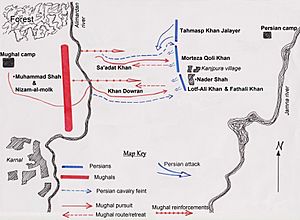
Despite being outnumbered six to one, Nader Shah crushed the Mughal army in less than three hours at the Battle of Karnal on February 13, 1739. After this victory, Nader captured Mohammad Shah and entered Delhi. A rumor spread that Nader had been killed. Some Indians attacked and killed Iranian soldiers. Nader was furious and ordered his soldiers to sack the city. On March 22, 20,000 to 30,000 Indians were killed. Thousands of women and children were taken as slaves. Mohammad Shah had to beg Nader for mercy.
Nader Shah agreed to leave. But Mohammad Shah had to give him the keys to his royal treasury. Nader took the famous Peacock Throne, which became a symbol of Iranian power. It is estimated that Nader took treasures worth seven hundred million rupees. He also looted the Koh-i-Noor and Darya-ye Noor diamonds.
The Iranian troops left Delhi in May 1739. Before leaving, Nader gave back all the territories east of the Indus to Muhammad Shah. The treasures were loaded onto 700 elephants, 4,000 camels, and 12,000 horses. The plunder was so vast that Nader stopped taxation in Iran for three years after his return. Many historians believe Nader attacked India to give his country a break from its own troubles. His successful campaign gave him funds to continue his wars against the Ottomans and in the North Caucasus.
Later Campaigns and Decline
The Indian campaign was the peak of Nader's career. After this, he became more and more harsh as his health got worse. Nader had left his son, Reza Qoli Mirza, to rule Iran while he was away. Reza had acted cruelly and made preparations to become king, thinking his father had died. He even had the former Shah Tahmasp and his family killed. Nader was not pleased with his son's actions.
In 1740, Nader conquered the Khanate of Khiva in Central Asia. He also forced the Khanate of Bukhara to submit. Nader wanted Reza to marry the Khan's daughter, who was a descendant of Genghis Khan. But Reza refused, so Nader married her himself.
Nader then decided to punish Dagestan for the death of his brother. In 1741, an assassin tried to shoot Nader. He was only slightly hurt. Nader began to suspect his son was behind the attack and confined him to Tehran. Nader's worsening health made his temper even worse.
Nader accused his son of the assassination attempt. Reza Qoli denied it, but Nader had him blinded as punishment. Nader immediately regretted it, crying out, "What is a father? What is a son?" Soon after, Nader began executing nobles who had seen his son's blinding. In his last years, Nader became very paranoid. He ordered the killing of many suspected enemies.
With the wealth from India, Nader started building an Iranian navy. He bought thirty ships from India. He recaptured the island of Bahrain from the Arabs. In 1743, he conquered Oman and its capital, Muscat. In 1743, Nader started another war against the Ottoman Empire. Despite having a huge army, he showed little of his former military skill. The war ended in 1746 with a peace treaty.
Nader's Policies
Nader changed the Iranian money system. He made silver coins called Naderi, which were equal to the Mughal rupee. Nader stopped the practice of paying soldiers with land. He also moved tribes around, like the Safavids did. Nader Shah turned the Shahsevan, a nomadic group, into a strong tribal group that defended Iran. He also increased the number of soldiers under his direct command. His changes may have made the country stronger, but they did not help Iran's struggling economy. He always paid his troops on time.
Nader also tried to create new ideas to connect Iran more closely with the Ottomans and Mughals. He focused on a shared Turkic background, suggesting that he, the Ottomans, Uzbeks, and Mughals all came from a common Turkic heritage. However, the Ottomans were not impressed by this idea.
He proposed a peace treaty with the Ottomans. In it, he claimed that the Persians had returned to the Sunni branch of Islam. This was mostly a political claim. Nader's army included many Sunni Pashtuns, Kurds, Turkmens, and others who preferred a less strict Persia. He presented Persia as completely Sunni to the outside world. He likely did this for political reasons to gain more acceptance in the Muslim world.
When Nader surrounded a city during a siege, he would build a temporary city outside its walls. This camp had markets, mosques, bathhouses, and stables. He did this to show the besieged city that his army would stay for a long time. It also helped prevent diseases and kept his troops busy.
Death and Legacy
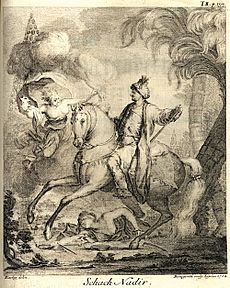
Nader became increasingly cruel due to his illness and his desire to collect more taxes for his wars. New rebellions broke out, and Nader crushed them harshly. In 1747, Nader went to Khorasan to punish Kurdish rebels. Some of his officers and relatives feared he would execute them. They plotted against him.
Nader Shah was killed on June 20, 1747, in Quchan in Khorasan. He was attacked in his sleep by about fifteen plotters. Nader managed to kill two of them before he died.
After his death, his nephew Ali Qoli became king, renaming himself Adel Shah ("righteous king"). Adel Shah was likely involved in the plot to kill Nader. However, Adel Shah was removed from power within a year. After Nader's death, his empire fell into chaos. Almost all provincial governors declared independence. Oman and the Uzbek states regained their freedom. The Ottoman Empire took back lost territories.
Eventually, Karim Khan founded the Zand dynasty and became the ruler of Iran by 1760. In the far east, Ahmad Shah Durrani declared independence, creating modern Afghanistan. Iran also lost Bahrain.
Nader Shah was well known in Europe during his time. His invasion of India showed the East India Company how weak the Mughal Empire was. This led to the British expanding their rule in India. Some historians believe that without Nader, British rule in India would have happened later or differently.
Nader's military success was almost unheard of for Muslim Shahs. He was compared to Alexander the Great in Europe. Napoleon Bonaparte also admired Nader Shah and saw himself as a new Nader.
Nader lived a simple life. He preferred plain clothes and disliked the fancy lifestyles of the Safavids. He ate simple foods and did not get caught up in luxury, unlike some previous rulers.
Images for kids
-
Afsharians parade in Persepolis
See also
 In Spanish: Nader Shah para niños
In Spanish: Nader Shah para niños
- Nader Shah's Central Asian campaign
- History of the Caucasus
- Afsharid navy
- Safavid conversion of Iran to Shia Islam
- Treaty of Resht
- Jahangusha-i Naderi, the most important book on the reign and wars of Nader Shah





